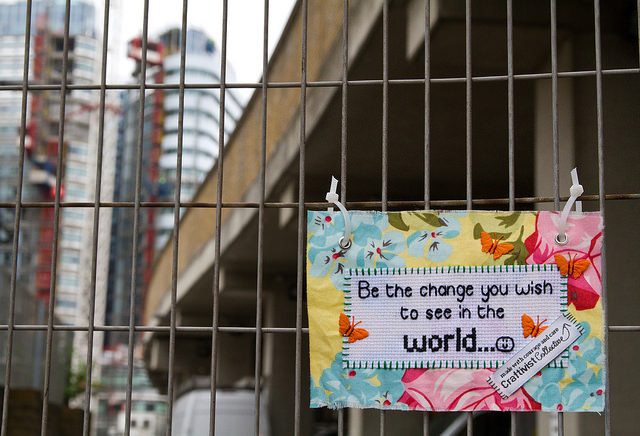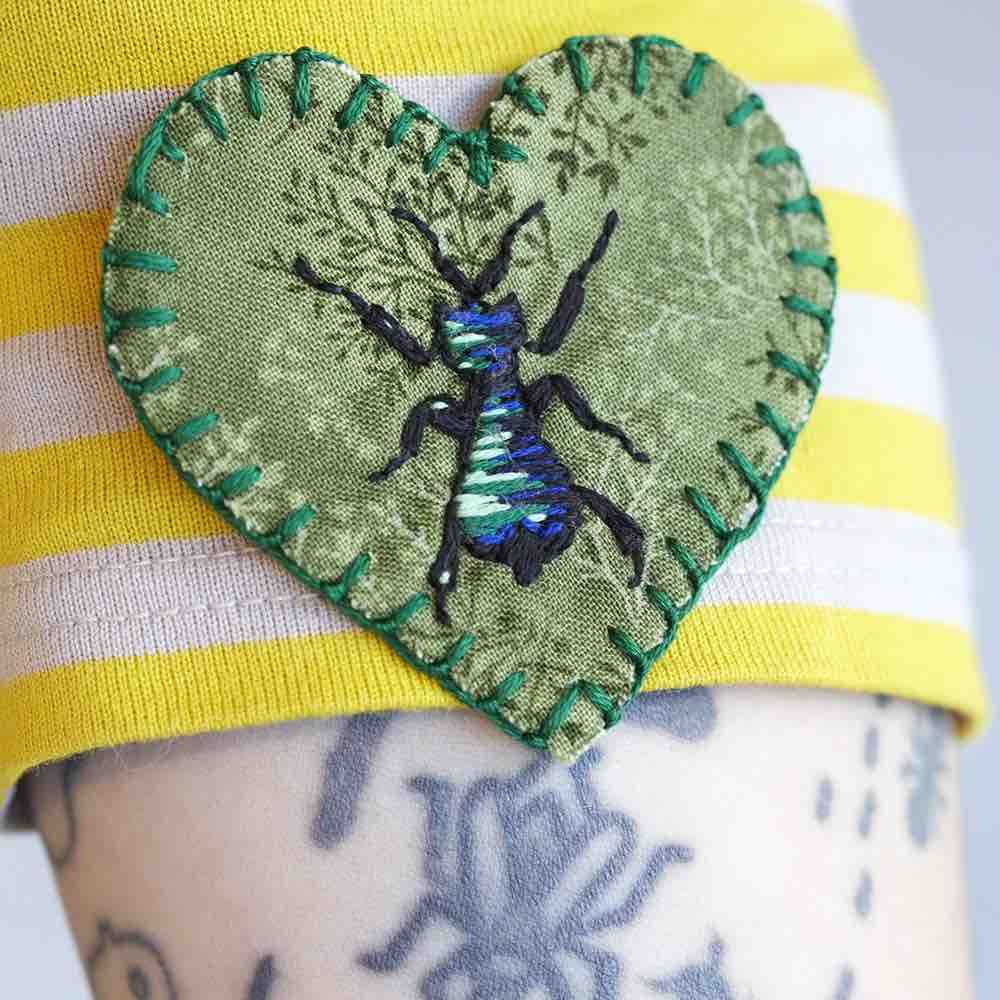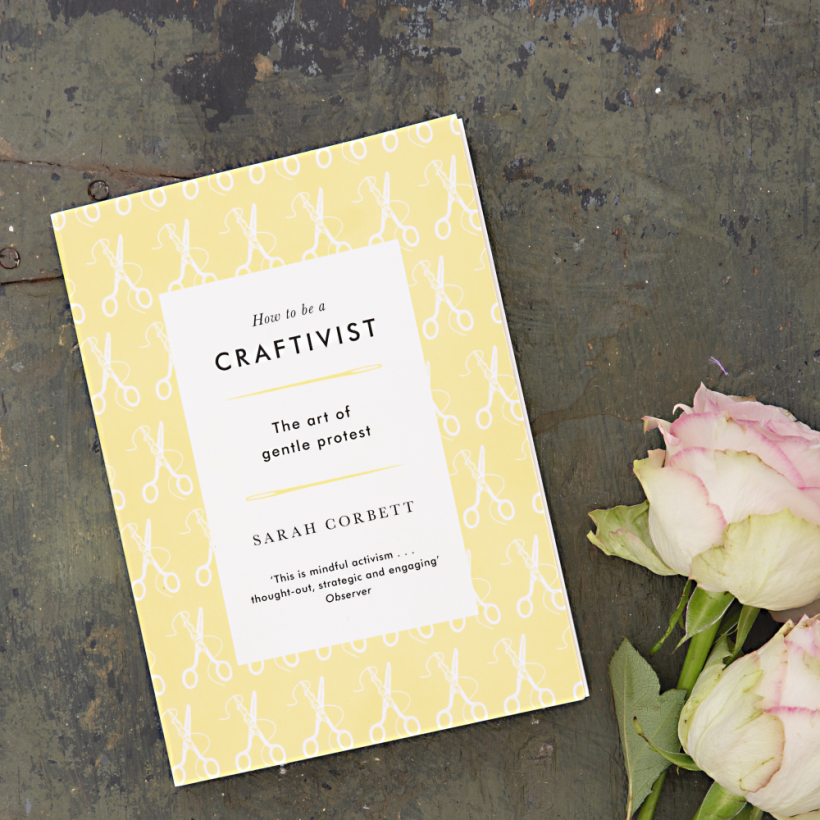
Delicate, fragile, contemplative: this is the modus operandi of Craftivist Collective.
By BEL JACOBS
This September, during London Fashion Week, high street shoppers may have been surprised to find tiny handwritten notes in the pockets of their new purchases. Each note, tied with a ribbon, contained questions and phrases about the hidden realities of fashion. They included thoughts such as ‘Our clothes can never be truly beautiful if they hide the ugliness of worker exploitation” and “If we are what we wear, shouldn’t we try to make sure our clothes are made by garment workers who get paid well?”
Delicate, fragile, contemplative: this is the modus operandi of Craftivist Collective, a group of “gentle activists” that protests against injustices in a quiet, non-confrontational manner involving pretty, handcrafted gestures of defiance. Now, founder Sarah Corbett pulls together the threads of her philosophy in a new book, “How to be a Craftivist: the art of gentle protest”, in which personal stories – moments of epiphany as well as the human interactions that have guided her way – are interwoven with practical theories of gentle activism.
The Collective has produced consistently moving, imaginative campaigns; actions that amaze and amuse in equal measure, but where the amazement and amusement is underpinned by an urge to question some of society’s deepest inequities.
To support The Climate Coalition’s “For The Love Of Climate” campaign in the run up to COP21 in 2015, the Collective created green felt hearts, to be worn on sleeves and lapels, decorated with whatever motifs stitchers loved most, from bugs to teddy bears.

In another project, in a workshop at the V&A around Refugee Week, Corbett asked attendees to stitch their own luggage tags, using them to reflect on what home meant to them and what refugees might be going through when they lose theirs.
Corbett’s unique approach to changing the world was honed after years working as professional campaigner for NGOs including Christian Aid and Oxfam, and the Department for International Development (DFID). Until she almost burn out.
“We’d slipped into just getting people to sign petitions. You’d win awards on petitions,” she recalls, during a talk at the Art Workers Guild earlier this month. “i was treating people like robots and, at the same time, I was thinking, we could do this so much better.”
The Collective was born, quite accidentally, with a cross stitch kit on a long train journey. ’And immediately, it slowed me down. It forced me to notice me to notice how tight my body was, how shallow my breathing.”
“And with that comfort, I could ask myself, am I being effective? Am I teaching people to be good activists? It gave me a way of grappling with issues that were disturbing me.”
That contemplative quality is key to all Corbett’s work. The Collective sells little sewing kits (all ethically made in the UK) on its website. Each comes complete with materials – threads and needles, tiny pieces of reclaimed cotton or felt made from recycled polyester, instructions and, almost most importantly, a list of questions for you to reflect upon as you sew.

The power of the community: one of the Collective’s key themes.
Similarly, the book is about far more than finding the perfect stitch for your banner. Corbett writes about the power of beauty; about the tender efficacy of using natural motifs or your own handwriting – and about how the pretty imperfections embedded in the art of crafting make it more approachable.
She explores the art of enabling collaboration rather than confrontation, about asking questions rather than telling people what to do and about the power of gifting. “A lot of activism is trying to take power away,” she says. “Making a gift can be very humble.”
Corbett’s fine mind introduces the novice to the freedom and possibility of creative thought, placed at the service of higher aims. Why just write a board member a letter when you can stitch her a gentle note, in your own handwriting, decorated with motifs you know she’d like?

Ask questions rather than tell people what to do.
Finally, Corbett writes about the importance of taking care of yourself because, sometimes, as she will knows, caring about the planet, its people and its animals can leave you in despair. Corbett celebrates the almost mandala-like quality of craft to help you through it.
“Most of the time, you don’t get a quick win,” Corbett says of campaigning. “Activism is the long haul. Craft is good for self care.”
In the end, How to be a Craftivist is a “manifesto, for a more respectful activism, for conversation where too often there is division and conflict, for using craft to engage, employer and encourage us all to be the change we wish to see in the world.”
Sign us up.






